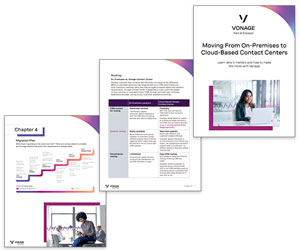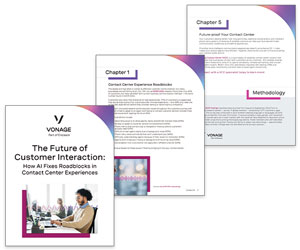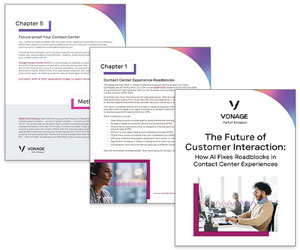Tim Kimber at Vonage explains how contact centre agents can improve customer experience (CX) with unified communications.
Are contact centres equipped to meet the expectations of the modern customer? While companies are aware of the growing importance of the CX as a unique selling proposition, many still rely on a contact centre model designed for yesteryear’s market.
The result is a disconnect between what companies aspire to — an organisation-wide focus on putting the customer experience first — and what they’re capable of achieving in reality, with a legacy communications system that separates the contact centre from the rest of the business.
A unified communications system can help solve this bottleneck.
Common Customer Experience Challenges Contact Centre Agents Face
Even the best contact centre employees typically have to work with an internal communications system that makes providing an optimised CX a challenge. There are a number of reasons for this.
1. No Visibility Into the Rest of the Organisation
To solve certain problems or address specific queries from customers, contact centre agents often require the help of specific departments or specialists from elsewhere in the company.
However, they generally don’t know if the required person or specialist is available, particularly when some or all of the company may be working remotely.
The result is that a calling customer is kept on hold for a prolonged period of time while the agent tries to identify and contact the right person. If they can’t, they may ask the customer to call again later or say that they’ll call the customer back at a later time or date.
And mainly due to internal processes, that call back often never happens, leaving the customer even more frustrated and unsatisfied.
2. Difficulty in Making the Right Routing Decisions
It happens time and again. A customer calls with a query that requires a specific department’s attention, but the contact centre agent mistakenly routes the caller to the wrong person.
This tends to occur because it’s unclear which department or team is responsible for handling specific types of queries. As a result, a caller may be transferred multiple times and be put on hold repeatedly.
3. Managing Multiple Login Credentials and Different Platforms
Contact centre agents typically have to use multiple login credentials for different systems and procedures.
Moreover, the platforms that contact centres use are generally different and separate from those used elsewhere in companies, making collaboration and smooth internal communications a tall order.
These inefficiencies undermine agents’ ability to respond to customer queries appropriately.
A Unified Communications System Positions Agents to Best Serve Customers
Changing the way a company operates its contact centre and internal processes can seem like a big step. But the reality is that companies that fail to do so risk losing their competitiveness.
With increasing market demands for a stellar CX, the companies that meet modern-day customer needs and wants will be best positioned to succeed.
By unifying communications across the entire organisation, companies enable their contact centre agents to achieve optimised CX performance.
Presence Availability
Companies can use presence information technology, which equips contact centre agents to instantly view when colleagues from across an entire organisation are available.
When combined with an internal uniform communications system that includes calls, messaging, and even video meetings, presence information technology helps agents solve any calling customer’s issue the first time, without lengthy waiting times or the need to call them back.
A Common Internal Directory
A benchmark unified communications system should include a common directory of every employee.
A single directory makes collaboration between contact centre agents and employees from elsewhere in the company easier and faster.
It also improves the accuracy of routing, as agents have a reference to guide their decision-making.
Single Sign-on
With single sign-on, gone are the days of fumbling around with various login credentials. Agents can work with one centralised platform.
Not only does this improve operational efficiency, but it also reduces the need for patch updates across platforms and training updates.
Common Call Controls
Rather than have a different set of processes across different departments, implementing common call controls across a company creates consistency and uniformity in communication and process. This improves communication between the business and call centre, helping agents provide a better CX.
Upgrading the Customer Experience With Unified Communications

Tim Kimber
When a company aligns its internal communications process across the contact centre and the rest of the organisation with a flexible, cloud-based communications platform, agents can address customer queries faster and more precisely.
The result is that customers end an interaction satisfied, which in turn leads to greater loyalty.
In addition to the considerable gains that a unified communications platform can generate for CX, it also helps companies improve employee engagement and interdepartmental collaboration.
Author: Guest Author
Published On: 18th Feb 2021 - Last modified: 14th Jun 2024
Read more about - Archived Content, Tim Kimber, Vonage



















